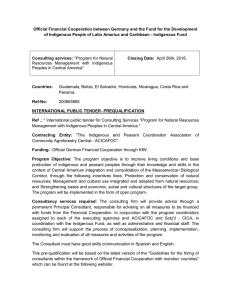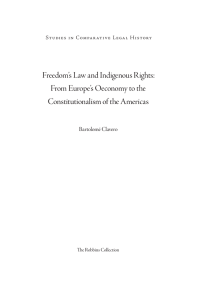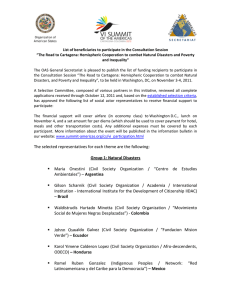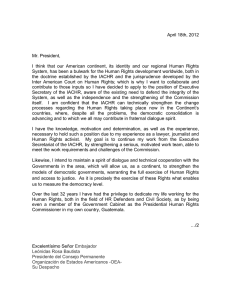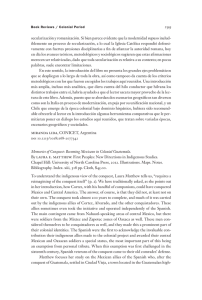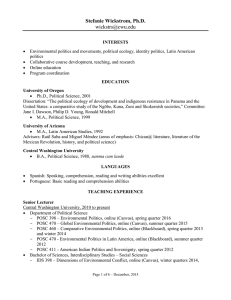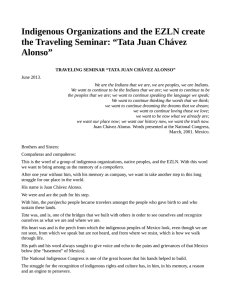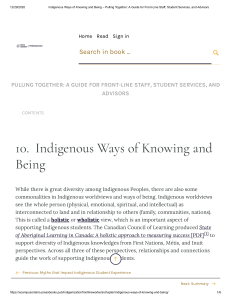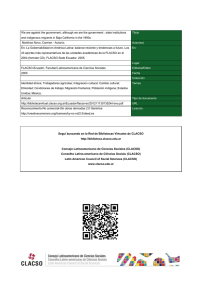Once Upon a Time There Was an Indian
Anuncio
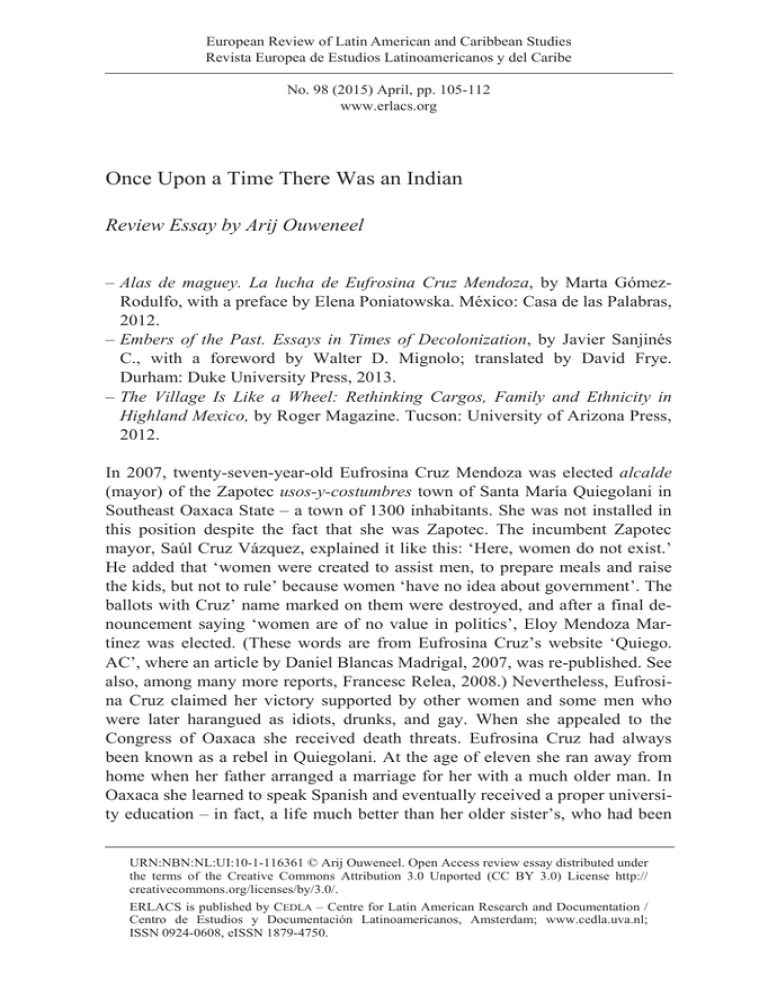
European Review of Latin American and Caribbean Studies Revista Europea de Estudios Latinoamericanos y del Caribe No. 98 (2015) April, pp. 105-112 www.erlacs.org Once Upon a Time There Was an Indian Review Essay by Arij Ouweneel – Alas de maguey. La lucha de Eufrosina Cruz Mendoza, by Marta GómezRodulfo, with a preface by Elena Poniatowska. México: Casa de las Palabras, 2012. – Embers of the Past. Essays in Times of Decolonization, by Javier Sanjinés C., with a foreword by Walter D. Mignolo; translated by David Frye. Durham: Duke University Press, 2013. – The Village Is Like a Wheel: Rethinking Cargos, Family and Ethnicity in Highland Mexico, by Roger Magazine. Tucson: University of Arizona Press, 2012. In 2007, twenty-seven-year-old Eufrosina Cruz Mendoza was elected alcalde (mayor) of the Zapotec usos-y-costumbres town of Santa María Quiegolani in Southeast Oaxaca State – a town of 1300 inhabitants. She was not installed in this position despite the fact that she was Zapotec. The incumbent Zapotec mayor, Saúl Cruz Vázquez, explained it like this: ‘Here, women do not exist.’ He added that ‘women were created to assist men, to prepare meals and raise the kids, but not to rule’ because women ‘have no idea about government’. The ballots with Cruz’ name marked on them were destroyed, and after a final denouncement saying ‘women are of no value in politics’, Eloy Mendoza Martínez was elected. (These words are from Eufrosina Cruz’s website ‘Quiego. AC’, where an article by Daniel Blancas Madrigal, 2007, was re-published. See also, among many more reports, Francesc Relea, 2008.) Nevertheless, Eufrosina Cruz claimed her victory supported by other women and some men who were later harangued as idiots, drunks, and gay. When she appealed to the Congress of Oaxaca she received death threats. Eufrosina Cruz had always been known as a rebel in Quiegolani. At the age of eleven she ran away from home when her father arranged a marriage for her with a much older man. In Oaxaca she learned to speak Spanish and eventually received a proper university education – in fact, a life much better than her older sister’s, who had been URN:NBN:NL:UI:10-1-116361 © Arij Ouweneel. Open Access review essay distributed under the terms of the Creative Commons Attribution 3.0 Unported (CC BY 3.0) License http:// creativecommons.org/licenses/by/3.0/. ERLACS is published by CEDLA – Centre for Latin American Research and Documentation / Centro de Estudios y Documentación Latinoamericanos, Amsterdam; www.cedla.uva.nl; ISSN 0924-0608, eISSN 1879-4750. 106 | ERLACS No. 98 (2015) April given away ‘in property’ to another Zapotec community member in Quiegolani; she ended up having nine children. Within a year of Eufrosina Cruz’ failed attempt to be elected mayor, she had become the figurehead of a women’s movement in Oaxaca that united all social classes and ‘ethnic’ groups and combatted reactionary ‘indigenous’ politics. Oddly, Eufrosina Cruz found political refuge with the National Action Party (PAN), a conservative party led at that time by President Felipe Calderón (2006-10). This interesting history has been skilfully recorded by Spanish reporter Marta Gómez-Rodulfo; and beautifully illustrated with photographs by Antonio Turok. Alas de maguey. La lucha de Eufrosina Cruz Mendoza serves as a manifesto against the male dominance by Zapotec traditions. Most certainly, Mexico’s southern state of Oaxaca is known for its many communities that apply a specific style of governance called usos y costumbres or customs and traditions; 418 out of 570 municipalities practice this type of government (73 per cent). It doesn’t take much research to understand that this style has survived from the república de indios of the Spanish era. After the Revolution of 1910 these traditions continued to be tolerated. Lynn Stephen, a distinguished anthropologist of the Zapotec-speaking population of Oaxaca, defines usos y costumbres as ‘indigenous claims to local governance and legal autonomy through customary indigenous law and systems of governance in Mexico’ that are ‘built around different understandings of rights, justice, punishment, and security than those of the state’ and officially recognized by the Congress of the State of Oaxaca in 1994 (Stephen, 2013, quotes from pp. 30, 278, and 69, respectively). One may note that Mexico is the only country in Latin America that officially recognizes elections through ‘usos y costumbres’ and Oaxaca is its showcase. But a chain is no stronger than its weakest link. At first the actions of Eufrosina Cruz concerning the abusos y costumbres or ‘abuses and customs’ of women’s rights under ‘indigenous’ rule were understood by the men in power as an assault on the ‘indigenous’ case (Eisenstadt, 2013, p. 7). Nevertheless, when opposing groups that claimed to defend ‘authentic customs’ were confronted with violent conflicts between ‘indigenous’ municipal factions, one participant responded with: ‘What we have doesn’t work anymore; what we need are new customs.’ (See more on Eufrosina Cruz in Juan Martínez, 2013, especially pp. 146-147, quote from p. 163.) The way we think about such matters is encoded in our cultural models, or, as the psychologists, linguists, cultural sociologists and art historians explain: in our cognitive schemas. The schema of the ‘indigenous’ is an old one. Like the ‘usos y costumbres’ for the indigenous, the ‘indios’ were encoded in schemas of the Conquistadors directly after they had invaded the Americas and named the Native Americans indios. This term was used at first because the ‘indios’ were thought to be the natives of Las Indias, the colonial name for the Americas. Later the Spanish Crown created the indio as a classification by law. The indio was a specific type of subaltern of one of the many kingdoms that were united under the Spanish crown. During that period, the kingdoms were Arij Ouweneel: Once Upon a Time There Was an Indian | 107 divided into separate government units called repúblicas – we may understand them today as ‘estates’ or estamentos. The indios formed the república de indios and were governed by their own noblesse (caciques or principales in the offices of gobernador, alcaldes and others forming their own cabildo de indios), and supervised by the Juzgado de Indios, a ministry of the Audiencias, and the viceroy and his local provincial official (Coregidor or Alcalde Mayor). The Church worked with a similar structure. To be able to execute this responsibility the Amerindian noblesse was educated in special colleges to become gente de razón. Indios lacking this education were considered to be gente sin razón or children (and not as female or effeminate as in other colonized parts of the world). The indios’ childlike status of innocence corresponded strongly with the idea of the noble savage that had predominated European ideas about the people of the ‘West’ – that is anywhere west of Europe in the Atlantic Ocean. It was ‘known’ that in that West a paradise-like world had preceded the European civilization. Think of Atlantis and the Golden Age of ancient history; Saint Brendan had been there. These ‘Westerners’ were considered to be a highly civilized people, urban but also living close to nature in an egalitarian state. Or, as the Dutch philosopher Ton Lemaire called it in his well-researched book De Indiaan in ons bewustzijn (1986), because of the Indian in Our Consciousness, the European knew the Indian before he had actually seen him. With Columbus, the Europeans had rediscovered the ‘truth’ of the myth of Atlantis and the Golden Age. Around that time, a Cognitive Amerindian Schema (CAS) must have formed regarding the noble savage in the West who led an uncorrupted, natural way of life, even though actual Amerindians found in the Americas were usually city dwellers. No doubt, the CAS was recodifed when the Spaniards took over in the Americas. The new schema was bipolar: white ([former] colonizers) versus non-white ([former] colonized) – and, for Spain’s enemies it was the brutal versus the innocent. This strict bipolar separation of two groups is known as the Colonial Divide. Working with Carole Pateman’s study on the ‘sexual contract’ (1988), sociologist Charles Mills (1997) theorized that this type of colonial recodifications is a racial contract. The sexual contract is also a dichotomy: male versus female. The colonial world privileged white men versus non-white men and all women in general. The Bi(polar)-CAS teaches us that the decolonization of the Colonial Divide is part of its predicted ending, with eventually everyone included on the white side: a process referred to as ‘whitening’. Based on its global northern origins and working as a bipolarity, the classical Bi-CAS privileges the world of the whites and expects the ‘indigenous’ to ‘whiten’ if they want to adopt characteristics and artefacts of the modern world. It starts with a softer type of whitening when people do not close the gap between white and indigenous but instead switch sides; a switching which often is also called mestizaje. In Mexico, switched indigenous are called mestizos, in Guatemala ladinos, in Peru mistis. Other decolonializing activities are also possible, such as blurring the 108 | ERLACS No. 98 (2015) April boundaries between the extremes and transforming the dichotomies into continua. A continuum is open to both extremes and leaves room for mutual influences and the adoption of each other’s characteristics, attitudes, stereotypes and artefacts, or elements of them. This is the multicultural stance. However, since Eufrosina Cruz’ activities were still bound up in the daily practices of the Bi-CAS, that is, operating from the ‘indigenous’ side of the dichotomy only, her decolonizing attitude was perceived as directed towards the destruction of the sexual contract. Because its articulation was also part of the racial contract, her opponents further experienced her activities as the destruction of indigenous rule in Oaxaca. Decolonization is a complicated matter. Reading Embers of the Past: Essays in Times of Decolonization (2013) by the Bolivian-born Javier Sanjinés, who teaches Latin American Literature and Cultural Studies at the University of Michigan in Ann Arbor, we learn that the destruction of the white side of the dichotomy remains a popular approach. Even though Europeans and Africans have been in the Americas for 500 years, whites are still treated as alien to the continent. Sanjinés belongs to a group we could call the Decolonialists. This predominantly male group includes Walter Mignolo (who wrote the foreword to the book), Santiago Castro-Gómez, Fernando Coronil (deceased in 2011), Enrique Dussel, Arturo Escobar, Ramón Grosfoguel, Aníbal Quijano, Boaventura de Sousa Santos, and Catherine Walsh. Based on an article by Quijano (1992 and 2000), their work on the persistent presence of the colonial ordering in contemporary Latin America can be seen as a reaction to the Anglo-Saxon, African and Asian groups discussing the post-colonial theory. Their theorizing is about the possibilities of decolonization through ‘indigenous politics’ – ‘liberating’ the formerly colonized peoples. This can only improve the world, Sanjinés suggests, because the ‘indigenous’ belong to what is known as postcapitalism, described by the author as ‘alternative capitalism, hybrid practices of capitalism and indigenous communalism’. The crisis of modernity theorized by the Decolonialists is an indication that capitalism has become obsolete. In short, they turn against the idea that becoming modern includes becoming white. ‘Indigenous communalism’ is part of the alternative, implying ‘decolonial communal forms of exercising politics’. Today’s ‘indigenous movements’ defined as ‘societies on the move’, says Sanjinés, ‘appear to be changing the rules of the game [of modernity], making the ‘non-contemporaneous’ possible in multiple nations whose respective cosmogonies can disrupt the spatialtemporal form of the nation-state’. If they succeed, Sanjinés believes that we may ‘heal’ a ‘longed-for integration’. Set in the schema of modernity, the ‘indigenous’ are not a premodern feature from the past, but the anticipation of the future. Sanjinés further insists ‘that a transformation of the self should take place, beginning by overcoming the egocentrism of modernity’ (Sanjinés, 2013, quotes from pp. 9 [twice], 27, 24, 25, 56, 27, respectively). Curiously, this is the Nobel Savage versus the Ignoble Savage again – the Bi-CAS, indeed. In that sense, Decolonialists like Sanjinés fall back on the old method, Arij Ouweneel: Once Upon a Time There Was an Indian | 109 popular in the days of Jean-Jacques Rousseau (1712-78), of using the ‘indigenous’ as a mirror to global northern society. Comparable to the indio that confirmed the idea of the Noble Savage, Sanjinés’ indígena – the indio made accessible to the authors of contemporary ethnic politics – offers nothing but the eternal good. Still another voice comes from Roger Magazine of the Universidad Iberoamericana in Mexico City. His The Village is Like a Wheel (2012) comes closest to Sanjinés’ position of inviting his readers to look at classical issues in Mesoamerican ethnology in a novel way – the cargo system, kinship, and indigeneity. Contrary to Sanjinés, however, Magazine’s information comes from years of fieldwork in the Texcoco area east of Mexico City, where he researched the former pueblo de indios of Tepetlaoxtoc. The book suggests that if we would map local culture, we could end up filling in a cultural continuum. Despite the rural occupation of fattening cattle, the villagers are occupied with other typically urban capitalist activities such as wage labourer in construction work, salaried employee in the city, or worker in a maquila assembling clothes, all of which posit them on the continuum near or among the city people of adjacent Mexico City. Their patterns of consumption are almost ‘city-like’ in that they buy machines and urban household goods including televisions and computer gear. The dichotomous approach is hard to verify, which convinced Magazine to refuse speaking of ‘indigenous’. The designations ‘Nahua’ and ‘indígena’ are gradually disappearing from the Texcoco area. The old language is still spoken in parts of the towns in the area, but in general Spanish has become more prevalent over time. Is Tepetlaoxtoc considered a mestizo town? No, it is not. The population enthusiastically cherishes a communal way of living that Magazine describes as ‘motivating others to act’. These ‘communal ways of living’ would certainly qualify elsewhere in Latin America as ‘indigenous’, as for example it does for the Mapuche in Chile. The ‘collective’ action finds its quintessential purpose in making other community members be active in ‘doing’. Indeed, the ‘community’ is made up of ‘doing’. The family functions not simply for biological reproduction but for a kind of cultural reproduction as the site for reproducing this ‘doing’. Helping and assisting family members is not an end in itself, it is the means to creating active subjectivity in each family member. The same can be said of the local fiesta system: The fiestas are not an end in themselves, but a means to activate the community members by coaxing them to work together, or, better perhaps, to perform being the community. In providing a wealth of information full of ethnographic observations and anecdotes appealing to our imagination, The Village Is Like a Wheel demonstrates that the community does not collectively produce artefacts like fiestas and family networks, but through these artefacts produces itself as active subjectivities in its constituting members. Community members, who do not participate this way, fall outside the community; outsiders that actively participate are welcomed ‘in’. 110 | ERLACS No. 98 (2015) April These activities have ancient roots but they are not recognized by the people themselves as something ‘indigenous’. This is because the usual mode identifies the ‘indigenous’ by its produced artefacts as identity markers – such as traditions, social structures, rituals, myths, and so forth. The Village is Like a Wheel is built on the idea that the ‘indigenous’ ‘had never defined themselves in terms of things … that they had produced and possessed, and so such a definition had to be invented for the sake of government agencies or other actors that do recognize another though its culture’ (Magazine, 2012, quotes in this paragraph from p. 105). The indigenous cannot identify when something is ‘indigenous’ or not. Magazine found that identity markers in the Texcoco towns have little meaning for people ‘who do not share our [global northern] notions of culture, self, and otherness’. Perhaps as any other ‘indigenous’ people, the people of Tepetlaoxtoc see no relevance in terms like ‘culture’, ‘ethnicity’, or ‘modernization’ to describe their activities. For them, these products are conduits or by-products of ‘actions directed toward the production of active subjects’, of a ‘doing’ that would involve individuals together. In short, following The Village Is Like a Wheel, the CAS does more justice to Latin America’s ‘indigenous’ heritage than its bipolar counterpart that is solely directed to political and cultural struggle, especially if we transform it into a kind of Continuous Indigenous Schema or CIS. Indeed, The Village Is Like a Wheel shows that a CIS is a much more realistic tool for describing what happens in the decolonizing field. However, the tool is not yet widely accepted. The characteristics of the CIS are not only much more difficult to understand, they are also politically challenging because the CIS consciously avoids the formulation of a utopian view of the ‘indigenous’. For that reason, perhaps, the people described by the CIS are not seen as ‘indigenous’ or classified – in accordance with the norms of the classical Bi-CAS – as ‘whitened’, ‘non-indigenous’ mestizos. Now that I have read Magazine’s case against the Bi-CAS, arguing cogently that something like an ‘indigenous culture’ has never existed as such, I cannot help concluding that the terms ‘indigenous’ and ‘indigeneity’ have always been scholastic concepts with no practical local significance. Whether the people of Tepetlaoxtoc can be conceptualized as belonging to ‘modernity’ or not – which is Sanjinés’s major effort – is of no relevance at all to them. In regard to my own research on mestizaje in Mexico and Guatemala and on cholification in Peru over the past years (for the latter, see also Annelou Ypeij’s exploration in issue 94 [2013] April of this journal), I have always felt that, seen from the ‘indigenous’ side, bipolarization had only been administrative, never cultural. The bipolar administration was very welcome because the república de indios under Spanish rule provided the indios with a kind of semiautonomy and semi-self-rule as well as protection from the encroachment of their lands and labour and tribute obligations. Exploitation, poverty, the abuse of hacendados and the loss of lands reached their communities mainly in the nineteenth and twentieth century, when the Latin American economies became integrated into the modern imperialism of the global north. I think that the Am- Arij Ouweneel: Once Upon a Time There Was an Indian | 111 erindians would also recognize their entrance into a dark era of poverty and discrimination as a consequence of the increasing wealth of the global north of Western Europe and the US and less as a result of classical Spanish colonialism. The memory of this situation lives on in modern-day ‘indigenous movements’, using the scripts, scenarios and stereotypes of the Bipolar Cognitive Amerindian Schema as a straitjacket of all sorts of characteristics that binds the ‘indigenous’ to a rural lifestyle. Any designation as ‘decolonial’ in this case escapes me. Books such as Embers of the Past are no different from Thomas More’s Utopia (1516), confirming that the CAS still exists in its classical state and that it motivates a series of scholars, politicians and activists alike to treat the ‘indigenous’ accordingly. They would recognize the decolonial struggles of Eufrosina Cruz Mendoza, as described in Alas de maguey, only with difficulties. In fact, unlike the truly modern The Village Is Like a Wheel, Embers of the Past is written in a very old tradition indeed, thereby confirming the racial contract. *** Arij Ouweneel <[email protected]> is Associate Professor at CEDLA. Over the past few years he has changed his research of colonial history to contemporary history and is now working on a study on the ‘decoloniality’ in Peru. References Blancas Madrigal, D. (2007). Eufrosina Cruz ganaba alcaldía de Quiegolani, Oaxaca, pero por ser mujer le quitan el triunfo. Retrieved from http://www.cronica.com.mx/ notas/2007/339385.html (accessed 14 January 2014); also published at Cruz’s website Quiego. AC, at http://blog.quiego.org/search?updated-min=2007-01-01T00:00:00-08: 00&updated-max=2008-01-01T00:00:00-08:00&max-results=1 (accessed 14 January 2014). Eisenstadt, T.A. (2013). Introduction. Reconciling liberal pluralism and group rights: A comparative perspective on Oaxaca, Mexico’s experiment in multiculturalism. In T.A. Eisenstadt, M.S. Danielson, M.J. Bailón Corres, & C. Sorroza Polo (Eds.), Latin America’s multicultural movements. The struggle between communitarianism, autonomy, and human rights (pp. 3-17). Oxford: Oxford University Press. Juan Martínez, V.L. (2013). What we need are new customs. Multiculturality, autonomy, and citizenship in Mexico and the lessons of Oaxaca. In T.A. Eisenstadt, M.S. Danielson, M.J. Bailón Corres, & C. Sorroza Polo (Eds.), Latin America’s multicultural movements. The struggle between communitarianism, autonomy, and human rights (pp. 135-168). Oxford: Oxford University Press. Lemaire, T. (1986). De Indiaan in ons bewustzijn. De ontmoeting van de Oude met de Nieuwe Wereld. Baarn: Ambo. Mills, C. (1997). The racial contract. Ithaca, NY: Cornell University Press. Pateman, C. (1988). The sexual contract. Stanford, CA: Stanford University Press. Quijano A. (1992). Colonialidad y modernidad/racionalidad. Perú Indígena, 13(29), 11-20. 112 | ERLACS No. 98 (2015) April ––– (2000). Coloniality of power, eurocentrism, and Latin America. Nepantla: Views From the South, 1(3), 533-580. Relea, F (2008). La rebellion se llama Eufrosina Cruz. El País (Madrid) Retrieved from http://elpais.com/diario/2008/02/10/internacional/1202598001_850215.html (accessed 13 January 2014). Stephen, L. (2013). We are the face of Oaxaca. Testimony and social movements. Durham, NC: Duke University Press.
